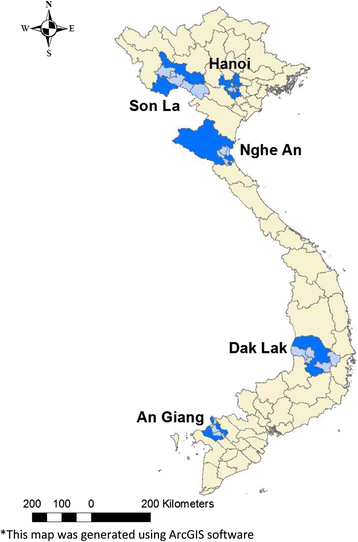Sero-prevalence of specific Leptospira serovars in fattening pigs from 5 provinces in Vietnam
- PMID: 28482843
- PMCID: PMC5422963
- DOI: 10.1186/s12917-017-1044-1
Sero-prevalence of specific Leptospira serovars in fattening pigs from 5 provinces in Vietnam
Abstract
Background: Leptospirosis is a zoonotic bacterial disease with a worldwide distribution. In Vietnam, leptospirosis is considered endemic. In pigs, leptospirosis can result in reproductive problems (such as abortion and infertility) which lead to economic loss. In addition, transmission to people presents a public health risk. In Vietnam, few national studies have been conducted on sero-prevalence of leptospirosis in pigs. The main objective of this study was to evaluate the sero-prevalence and incidence of presumptive infective leptospira serovars in fattening pigs from 5 provinces in Vietnam.
Results: Blood samples from fattening pigs were randomly collected at slaughterhouses. We collected 1959 sera samples from 5 provinces (Son La, Hanoi, Nghe An, Dak Lak and An Giang) between January and early June 2016. The microscopic agglutination test (MAT) was used to identify the serogroups/serovars. Overall, the sero-prevalence was 8.17% (95% CI: 6.99-9.47) and serovar Tarassovi Mitis (2.19%) had the highest prevalence followed by Australis (1.94%), Javanica (1.68%) and Autumnalis (1.17%) using a cutoff (≥ 1:100). The sero-prevalence among female pigs (5.28%, 95% CI: 3.94-6.93) was slightly higher than among male pigs (4.88%, 95% CI: 3.51-6.58), but this difference was not statistically significant.
Conclusions: Leptospirosis in pigs may be a useful indicator of the human/animal burden in Vietnam and a risk assessment tool. The presence of some of the identified serovars suggests that wildlife may play an important role in the transmission of leptospirosis to domesticated pigs in Vietnam. Therefore, strengthened monitoring and surveillance systems are needed to better understand the epidemiology of the disease and prevent or reduce infection in humans and animals.
Keywords: Leptospirosis; Microscopic agglutination test (MAT); Pig; Serovar; Vietnam.
Figures



Similar articles
-
Seroprevalences of multi-pathogen and description of farm movement in pigs in two provinces in Vietnam.BMC Vet Res. 2020 Jan 14;16(1):15. doi: 10.1186/s12917-020-2236-7. BMC Vet Res. 2020. PMID: 31937298 Free PMC article.
-
Seroprevalence and associated risk factors of leptospirosis in slaughter pigs; a neglected public health risk, western Kenya.BMC Vet Res. 2019 Nov 8;15(1):403. doi: 10.1186/s12917-019-2159-3. BMC Vet Res. 2019. PMID: 31703588 Free PMC article.
-
Seroprevalence of leptospirosis and Japanese encephalitis in swine in ten provinces of Vietnam.PLoS One. 2019 Aug 1;14(8):e0214701. doi: 10.1371/journal.pone.0214701. eCollection 2019. PLoS One. 2019. PMID: 31369564 Free PMC article.
-
[Leptospire infections in pigs: epidemiology, diagnostics and worldwide occurrence].Berl Munch Tierarztl Wochenschr. 2011 Sep-Oct;124(9-10):345-59. Berl Munch Tierarztl Wochenschr. 2011. PMID: 21950211 Review. German.
-
Epidemiology of leptospirosis in Tanzania: A review of the current status, serogroup diversity and reservoirs.PLoS Negl Trop Dis. 2021 Nov 16;15(11):e0009918. doi: 10.1371/journal.pntd.0009918. eCollection 2021 Nov. PLoS Negl Trop Dis. 2021. PMID: 34784354 Free PMC article.
Cited by
-
Reproductive Disorders and Leptospirosis: A Case Study in a Mixed-Species Farm (Cattle and Swine).Vet Sci. 2017 Dec 1;4(4):64. doi: 10.3390/vetsci4040064. Vet Sci. 2017. PMID: 29194353 Free PMC article.
-
Leptospira in Slaughtered Fattening Pigs in Southern Italy: Serological Survey and Molecular Typing.Animals (Basel). 2022 Feb 25;12(5):585. doi: 10.3390/ani12050585. Animals (Basel). 2022. PMID: 35268152 Free PMC article.
-
Seroprevalences of multi-pathogen and description of farm movement in pigs in two provinces in Vietnam.BMC Vet Res. 2020 Jan 14;16(1):15. doi: 10.1186/s12917-020-2236-7. BMC Vet Res. 2020. PMID: 31937298 Free PMC article.
-
Seroprevalence and associated risk factors of leptospirosis in slaughter pigs; a neglected public health risk, western Kenya.BMC Vet Res. 2019 Nov 8;15(1):403. doi: 10.1186/s12917-019-2159-3. BMC Vet Res. 2019. PMID: 31703588 Free PMC article.
-
Leptospiral Infection, Pathogenesis and Its Diagnosis-A Review.Pathogens. 2021 Feb 1;10(2):145. doi: 10.3390/pathogens10020145. Pathogens. 2021. PMID: 33535649 Free PMC article. Review.
References
-
- Alston JM, Broom JC, Doughty C. Leptospirosis in men and animals. Edinburgh: E&S Livingstone; 1958.
-
- Faine S. Leptospira and leptospirosis. Boca Raton: CRC Press Inc; 1994.
-
- Levett PN, Haake DA. Leptospira species (leptospirosis), Mandell, Douglas and Bennett’s principles and practice of infectious diseases. 7. Philadelphia: Churchill-Livingstone; 2010. pp. 3059–4005.
MeSH terms
LinkOut - more resources
Full Text Sources
Other Literature Sources
Miscellaneous

